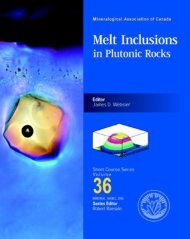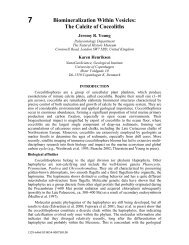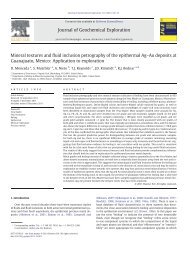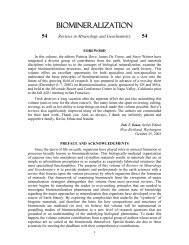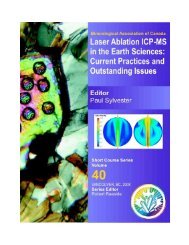You also want an ePaper? Increase the reach of your titles
YUMPU automatically turns print PDFs into web optimized ePapers that Google loves.
American Mineralogist, Volume 87, pages 1505–1508, 2002A technique for mounting and polishing melt inclusions in small (
1506THOMAS AND BODNAR: MOUNTING-POLISHING SMALL CRYSTALSSample Polishing Polisher ToolAdjustment ScrewTop View2.54 cm0.33 cm1 cm2.54 cmEpoxy-Tipped Rods forMounting CrystalsSide View2.92 cm2.21 cmFIGURE 1. Photograph (top) and line drawing (bottom) of thepolishing tool, adjusting screw and epoxy tipped rods for mounting<strong>crystals</strong>. In the photograph, the body, adjustment screw and two samplerods are shown to the left, whereas the assembled polishing tool witha rod and the adjustment screw inserted is shown to the right.Electron Microprobe MountSetscrewRods WithPolished CrystalsSetscrew0.31 cmEpoxy-Tipped Rods ContainingPolished CrystalsTop View2.54 cm0.33 cmSetscrewsSide ViewSetscrews2.54 cm1 cm1.27 cmFIGURE 2. Photograph (top) and line drawing (bottom) of theelectron microprobe mount and epoxy tipped rods containing polished<strong>crystals</strong>.is flush with the much larger metal surface of the polishingtool. This procedure assures that the surface is flat and perpendicularto the long axis of the rod. After cleaning and dryingthe rods, ~200 mL of epoxy (Buehler Epoxide resin no. 20-8130-032 and hardener no. 20-8132-008) is applied to one endof each rod with a dissecting needle. Experience has shownthat the best results are obtained if Buehler Epoxide resin andhardener are used because most other brands leave an excessof hardener after curing causing inadequate setting. The epoxyis mixed and allowed to cure for ~30 min prior to applying it tothe rod tips to ensure that the resin and hardener have adequatelymixed and reacted. Allowing the epoxy to cure for ~30 minbefore applying it to the polycarbonate rod increases its viscosity.This increased viscosity prevents the epoxy from flowingdown the side of the rod when the droplet is applied. Afterthe epoxy has hardened, epoxy tipped rods are ground to producea flat surface (Fig. 3b) following the same proceduresdescribed above to produce flat surfaces on the rods. After grinding,the epoxy on the rod tips is ~25–50% of its original thickness.The epoxy tipped rods are cleaned, dried, and stored untilneeded to mount individual <strong>crystals</strong>. This first application ofepoxy provides a base on which to mount the <strong>crystals</strong> and preventsthem from becoming detached from the polycarbonaterod during polishing.To identify <strong>crystals</strong> containing melt inclusions, the <strong>crystals</strong>are i<strong>mm</strong>ersed in refractive index oils (e.g., Cargille Type A,cat. no. 16482) and observed with a binocular microscope (Fig.3a). Selected <strong>crystals</strong> are cleaned in an appropriate solvent (e.g.,toluene) to remove the oil prior to mounting in epoxy. To mountthe crystal to the epoxy tipped rods, a small droplet of epoxy(
THOMAS AND BODNAR: MOUNTING-POLISHING SMALL CRYSTALS 1507FIGURE 3. (a) Zircon <strong>crystals</strong> in refractive index oil (n = 1.515). Two <strong>crystals</strong> in the center containing melt inclusions have been separatedfrom the other <strong>crystals</strong>. (b) Side view of a polycarbonate rod containing a zircon crystal in epoxy. The dashed line shows the boundary betweenthe polycarbonate rod and epoxy. Line A denotes the diameter of the polished surface of the epoxy, and lines B and B' denote the edges of thepolished epoxy droplet. Lines A, B, and B' are the same as those shown in (c). (c) Reflected light end view of a polycarbonate rod containing azircon mounted in epoxy and exposed at the surface. The bright ~0.4 <strong>mm</strong> annulus surrounding the polished surface is the sloping edge of theoriginal epoxy droplet (labeled B and B'). (d) Reflected light image of the same crystal as shown in (c) at higher magnification, showing thepolished zircon crystal, melt inclusion, and matrix glass.sets were selected for electron microprobe analyses and placedinto the probe mount (Fig. 2) as described above. Samples thatgave desirable results and which contained sufficiently largemelt inclusions (>30 <strong>mm</strong>) were selected for further analysisusing SIMS.The mount used for electron microprobe analyses is notnormally used to hold the samples for SIMS analyses becausethe polished <strong>crystals</strong> are not all at exactly the same height. Thisoccurs because tightening the setscrews causes slight randomdisplacements in the Z-direction. Minor height variations arenot generally a problem during electron microprobe analysesbecause the stage has an adequate range of Z-direction movement.However, slight vertical variations from one crystal tothe next are problematic during SIMS analyses due to the primaryion beam angle of incidence and low range of Z-directionmovement. Prior to SIMS analyses, the sample rods arepermanently cast in epoxy (Fig. 4). A 2.54 cm (outside diameter)standard aluminum ring form is placed on double-sidedIon Probe MountAluminumRing FormThin-WalledBrass Ring1 cmSampleRodsFIGURE 4. An ion probe mount with a 2.54 cm (outside diameter)standard aluminum ring and an internal 1.52 cm diameter thin-walledbrass ring. The sample rods are contained within the internal ring in aclose-packing configuration (~15 sample rods).
1508THOMAS AND BODNAR: MOUNTING-POLISHING SMALL CRYSTALStape. A 1.52 cm diameter thin-walled brass ring is placed in thecenter of the larger ring, and the sample rods are placed insidethis ring in a close-packing configuration (~15 sample rods)with the crystal-side placed against the tape. Both rings arefilled with epoxy and allowed to cure prior to removal fromthe double-sided tape. Minimal (if any) polishing may be necessaryto reduce minor height variations from one crystal tothe next prior to SIMS analyses. We note that the ion probemount described above may be inappropriate for H analyses ofmelt inclusions owing to the large volume of epoxy used(Dunbar and Hervig 1992). Additionally, other resins may bepreferable to Buehler for high vacuum applications.The technique described above was developed through trialand error, and has been found to be an effective means of exposingindividual melt inclusions contained within small (assmall as 50 <strong>mm</strong>) <strong>crystals</strong>. An added benefit of this technique isthat undesirable samples may be culled and those giving thebest results may be included in a final epoxy mount for furtheranalysis. This procedure assures that all (or most) of the samplesin the final mount will be suitable for SIMS analysis, minimizingthe amount of time that has to be spent changing mounts. Finally,we note that the technique described here may also be suitable forpreparing individual, small <strong>crystals</strong> for many other applications.ACKNOWLEDGMENTSThe authors thank Dan Smith for his assistance in the design and fabricationof the apparatuses described in this manuscript. The co<strong>mm</strong>ents of RobertTracy, Ross Angel, Meagan Elwood-Madden, and two anonymous reviewersgreatly improved the manuscript. Funding was provided by grant EAR-0001168from the National Science Foundation to Robert J. Bodnar and A. Krishna Sinha.REFERENCES CITEDDarling, R.S. and Bassett, W.A. (2001) Analysis of natural H 2 O + CO 2 + NaCl fluidinclusions in the hydrothermal diamond anvil cell. American Mineralogist, 87,69–78.Dunbar, N.W. and Hervig, R.L. (1992) Petrogenesis and volatile stratigraphy of theBishop Tuff; evidence from melt inclusion analysis. Journal of GeophysicalResearch, B, Solid Earth and Planets, 97, 15,129–15.Schiano, P. and Bourdon, B. (1999) On the preservation of mantle information inultramafic nodules; glass inclusions within minerals versus interstitial glasses.Earth and Planetary Science Letters, 169, 173–188.Schmidt, C., Chou, I-M., Bodnar, R.J., and Bassett, W.A. (1998) Microthermometricanalysis of synthetic fluid inclusions in the hydrothermal diamond-anvil cell.American Mineralogist, 83, 995–1007.Thomas, J.B., Bodnar, R.J., and Shimizu, N. (2002) Determination of zircon/melttrace element partition coefficients from SIMS analysis of melt inclusions inzircon. Geochimica et Cosmochimica Acta, in press.MANUSCRIPT RECEIVED MARCH 22, 2002MANUSCRIPT ACCEPTED MAY 21, 2002MANUSCRIPT HANDLED BY ROBERT F. DYMEK



